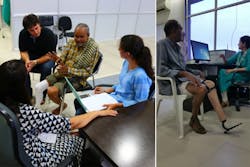Low-Cost Prosthetic Foot Lets Patients Walk Naturally
Prosthetic technology has advanced by leaps and bounds, but most high-tech designs cost tens of thousands of dollars, making them unattainable for many amputees, particularly those in developing countries. To sidestep that problem for patients needing a prosthetic foot, engineers at the Massachusetts Institute of Technology have developed a simple, low-cost, passive prosthetic that can be tailored to individuals. Given a user’s body weight and size, the researchers adjust the shape and stiffness of the prosthetic foot so that the patient’s walk resembles that of an able-bodied person. The biomedical researchers estimate that if the prosthetic was manufactured in large volumes, its cost would be an order of magnitude less than prosthetics currently on the market.
The artificial foot is based on a design which provides a quantitative way to predict a user’s biomechanical performance, or walking behavior. Almost five years ago, the team began looking for a way to quantitatively relate a prosthesis’ mechanical characteristics to the user’s walking performance, a fundamental relationship that had never been fully studied.
Although many developers of prosthetic feet focus on replicating the movements of able-bodied feet and ankles, the MIT team based their design on the knowledge that those who have lack or lost a limb below the knee can’t feel what the prosthetic foot is doing.
Instead of designing a prosthetic foot to replicate the motions of an able-bodied foot, the team designed the prosthetic so it would naturally recreate lower-leg motions similar to those of an able-bodied person’s lower leg as they walk.
With the lower leg in mind, the team looked for ways to relate how the mechanics of the foot relate to how the lower leg moves while the foot is in contact with the ground. To do this, it consulted a dataset of step measurements taken by an able-bodied walker with a given body size and weight. Each step recorded included the ground reaction forces and the foot’s changing center of pressure as it rocked from heel to toe, along with the position and trajectory of the lower leg.
Though the prosthetic does not even remotely mimic a foot, it lets patients develop a natural gait.
The MIT engineers developed a mathematical model for a simple, passive foot prosthetic which described the stiffness, possible motion, and shape of the foot. They plugged the ground reaction forces from the dataset into the model. The team adjusted the model foot’s stiffness and geometry to produce a lower-leg trajectory close to the able-bodied swing—a measure it considers to be a minimal “lower leg trajectory error.”
The team then sought to identify an ideal shape for a one-part prosthetic foot that would be simple and affordable to manufacture, but still generated a leg trajectory like those of able-bodied walkers.
To pinpoint an ideal foot shape, the group ran a “genetic algorithm,” a common technique used to weed out unfavorable options, in search of the best optimal designs.
The team created a series of differently shaped feet, then loaded them into the simulation to see which led to a lower-leg error. The ones that had a high error were eliminated.
Those with a lower error were mixed and matched with other shapes to get the shape with the lowest possible lower leg trajectory error. The team used a wide Bezier curve to describe the shape of the foot using only a few select variables, which were easy to vary in the genetic algorithm. The resulting foot shape looked like the side-view of a toboggan.
The team figured that tuning the stiffness and shape of this Bezier curve to a person’s body weight and size would allow it to produce a prosthetic foot that generates leg motions like those of an able-bodied walking person. To test this idea, the team, made several feet for volunteers in India. The prostheses were made from machined nylon, a material chosen for ability to store energy. They do not resemble a foot. They have no movable ankles, toes, or toe joints.
Going forward, the team has partnered with Vibram, an Italian company that manufactures rubber outsoles (flexible hiking boots and running shoes that look like feet). The company is designing a covering for the team’s prosthetics that will give the foot a more lifelike look and traction over muddy and slippery surfaces. The prosthetic foot can be a much more affordable and durable option for populations such as soldiers who want to return to active duty, or veterans who want to live an active lifestyle.
A common passive foot in the U.S. costs $1,000 to $10,000, and is made from carbon fiber. With this design, you can go to a doctor and have a few measurements taken, then for a few hundred bucks, a company will send back a custom-designed nylon foot.


